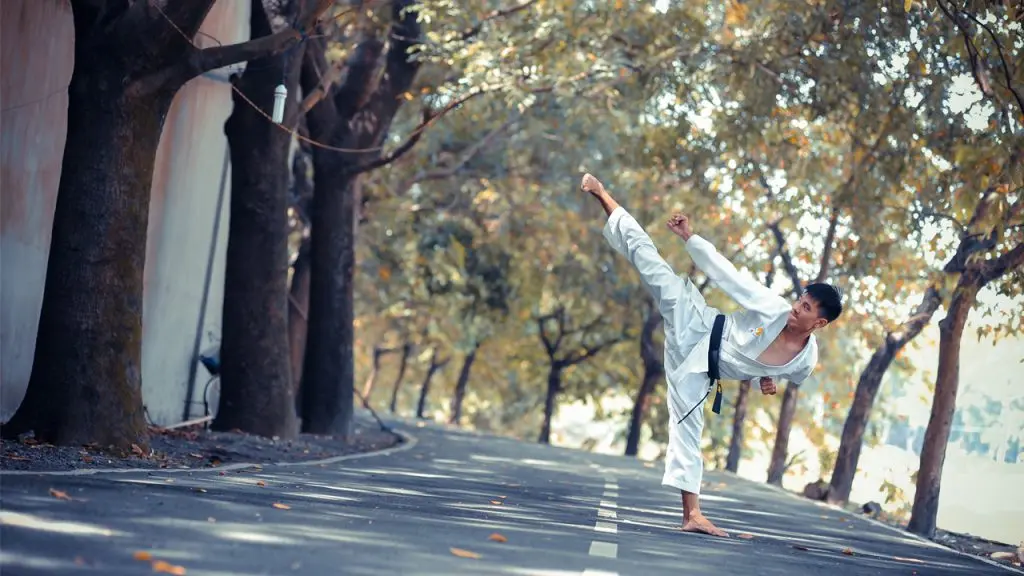Okay, so it’s probably unlikely that you’ll ever have to pit your self-defense skills against a giant — at least not of Biblical proportions. However, there are some real-life giants like André the Giant, a WWF champion best known for his role as Fezzik in the classic kids’ movie The Princess Bride.
Of course, it’s unlikely that you’ll ever run into one, and even less likely that you’ll have to fight one. But, in case you do, you’ll be thankful you read this article with tips and pointers on how to kick higher and harder. We promise it’ll serve you well even for regular-sized adversaries. So let’s dive in!
Table of Contents
Flexibility Is Key
Well, duh. Obviously, if you want to kick somebody in the head, you’re going to have to be flexible enough to reach it (or be able to jump really high). Jumping to head height for a precision kick to the jaw only seems possible for someone infused with kangaroo or frog genes or a very select few incredible athletes. The rest of us are going to have to focus on being more flexible.
So, how do you get more flexible?
My Tae Kwon Do Master from way back in the day told me that flexibility is all in our minds. Like if I were to pass out for whatever reason, she could arrange my body in a perfect split position, no problem. If I were to wake up in that position, it’s possible I would get hurt. However, it wouldn’t be because my body was incapable of the split, but rather that my brain thinks my body is incapable of doing it and the resulting brain freak out could make me pull a muscle.
To this day, I’m not 100% convinced she’s right, but if she is, that’s good news for all of us. Perhaps even the most inflexible among us can achieve that coveted high kick.
But So Is Strength
Flexibility, though important, is only one piece of the high-kick puzzle. You also need strength in certain muscle groups to get into the correct position and keep yourself from getting hurt.
Another theory about your brain and flexibility is based on the idea that you need enough strength to get into and out of extreme positions. If your brain knows you don’t have the strength to get out of a position, it won’t let you get into it in the first place.
Which muscles do you need to strengthen for a high kick? The answer will probably surprise you. Keep reading for the best strength exercises below.
And Balance
The last major piece of the high-kick puzzle is balance. When it comes to actually kicking someone there are a few more things to think about such as precision, timing, distance, power, etc. However, to simply perform the basic kicks, you need flexibility, strength, and balance.
Without balance, your kick will be short-lived. You might just manage to touch your target, but the force and awesomeness of your kick will be severely compromised by you falling on your fanny directly afterward. You might even break a couple of bones in your foot like I did back when I was a teenager.
So now that you understand the skills that you need to execute a high kick, let’s look at how to develop those skills.

5 Best Stretches Help to Kick Higher
We’ll start with stretching. Here are some excellent exercises to get you started. Some of them may feel a bit advanced for you at this point, but that’s okay, it gives you a goal to work up to.
As always when you’re stretching, don’t push so hard that you end up hurting yourself. Go to a point that is working the muscle, but is not painful. Hold for 30 seconds and, above all, remember to breathe! Long, slow, relaxing breaths will help you sink further into the stretch with each exhale.
1. Hamstring Stretch
This mom is doing a great demonstration of a hamstring stretch and getting a helping hand from her child while she’s at it! You can do the stretch with both feet out as she is doing or bend one knee in and place your foot flat on your inner thigh to go deeper on one side.
Sit up tall and lean forward, keeping your back straight. If you have to become a humpback to stretch farther, you’re doing it wrong. Your back must stay as straight as possible during this stretch. Flex your toes and grab them if you can to pull yourself down. If you can’t reach your toes yet, no worries, just keep trying and one day you will.
2. Lunging Side Stretch
Get into this stretch by standing with your feet wide apart, about four feet. Keeping your left foot facing straight forward, turn your right foot with the toes pointing away at a 90-degree angle to your other foot.
Stand up tall and stretch your arms straight out to the sides. Now, bend over to the right and place your right hand flat on the floor next to your right foot. The left arm reaches up over your head as far as you can. If you can’t stretch all the way just yet, try resting your right elbow on your right knee instead.
3. Torso Twist
Torso twists are great for stretching the abdominal obliques, quadriceps, and the large muscle groups in the torso — among other things. Stand with your feet wide apart, then bend over at the waist, keeping your back straight. Once you’ve reached waist height, reach one hand down toward the opposite foot.
The woman in the photo is doing a fairly advanced torso twist, but you can start torso twists by doing them standing straight up, then lying on the ground, then progressing to reaching for the opposite foot as described, and finally reaching the point where she is.
4. Pigeon Pose
If you want to loosen up those hip flexors and glutes, the pigeon pose is an excellent way to do it. To get into it, begin in a push-up position. Bring one leg forward, bending the knee and resting it horizontally on the floor under you. Push your hips down into the floor, allowing the straight leg to stretch out behind you.
Eventually, you’ll get to the point that you can take your hands up off the floor and hold the position like these two talented dancers.
5. Splits
The splits, both to the front and to the side are excellent exercises for kicking higher. If you can’t hold the static split on the ground, you can’t expect to reach up to head height in the air.
2 Basic Strengthening Exercises Help to Kick Harder
We hinted earlier that you might be surprised by the muscles you should target when you want to strengthen your kicks. Though it might seem logical, it’s not so much your leg muscles. While strong leg muscles will help, they are not the primary source of your power when kicking — your core is.
Think about it, when you’re kicking you’re just extending your leg. That doesn’t require much effort from your leg muscles. However, the strength and action from your core is what is sending that leg out strongly for a powerful impact.
On top of that, the primary muscles you need for balance again are not your leg muscles, but rather your core. Strengthen your core and you will immediately see an improvement in the height and power of your kicks without practicing a single kick.
So, time for so good-old-fashioned planks and pushups for a rock-solid core.
1. Planks
If you’ve done virtually any kind of exercise, you’re already familiar with the basic front plank. Place either both hands or both elbows on the floor with your toes as the only other point of contact. Hold your body completely straight for as long as you can (30 seconds to start). Try challenging yourself with a friend to see who can hold it longer.
Vary the exercise by doing one of the various side plank versions being demonstrated by the two strong ladies in the photo.
2. Scissor Kicks
Scissor kicks kill two birds with one stone when learning how to kick higher. You work on both strengthening your core muscles and improving flexibility.
Lie flat on your back, engage your core to raise your head and shoulders off the ground. Bring your legs up off the ground as high as you can go and still keep them straight. Now flutter them back and forth in a scissor motion. Your left leg goes down as your right leg comes up and vice versa. You can use your arms to help you in the beginning, but eventually, you should be able to hold the weight of your legs and perform the movement solely off the strength of your core.
How to Kick Higher and Harder?
There are a few more exercises and variations you can do, but these are the basics when it comes to learning how to kick higher and harder. To rattle your opponent’s brain with your incredibly high kicks, both figuratively and literally, you need flexibility, strength, and balance.
The good news is, you can attain all three through hard work and determination. Now get out there and get kicking! And learn more on Youtube videos:


